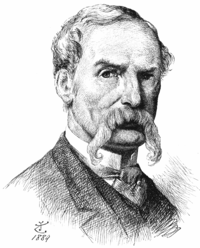John Tenniel
| Sir John Tenniel | |
|---|---|

Self-portrait of John Tenniel, c. 1889
|
|
| Born |
28 February 1820 Bayswater, London |
| Died | 25 February 1914 (aged 93) London, England, U.K. |
| Nationality | British |
| Known for | Illustration, Children's literature, Political cartoons |
Sir John Tenniel (28 February 1820 – 25 February 1914) was an English illustrator, graphic humourist, and political cartoonist prominent in the second half of the 19th century. He was knighted for his artistic achievements in 1893. Tenniel is remembered especially as the principal political cartoonist for Punch magazine for over 50 years, and for his illustrations to Lewis Carroll's Alice's Adventures in Wonderland (1865) and Through the Looking-Glass, and What Alice Found There (1871).
Tenniel was born in Bayswater, West London, to John Baptist Tenniel and Eliza Maria Tenniel. Tenniel had five siblings; two brothers and three sisters. One sister, Mary, was later to marry Thomas Goodwin Green, owner of the pottery that produced Cornishware. Tenniel was a quiet and introverted person, both as a boy and as an adult. He was content to remain firmly out of the limelight and seemed unaffected by competition or change. His biographer Rodney Engen wrote that Tenniel's "life and career was that of the supreme gentlemanly outside, living on the edge of respectability."
In 1840 Tenniel, while practising fencing with his father, received a serious eye wound from his father's foil, which had accidentally lost its protective tip. Over the years Tenniel gradually lost sight in his right eye; he never told his father of the severity of the wound, as he did not wish to upset his father further.
In spite of his tendency towards high art, Tenniel was already known and appreciated as a humorist and his early companionship with Charles Keene fostered and developed his talent for scholarly caricature.
Tenniel became a student of the Royal Academy of Arts in 1842 by probation—he was admitted because he made several copies of classical sculptures to provide the necessary admission portfolio. So, it was here that Tenniel returned to his earlier independent education. While Tenniel's more formal training at the Royal Academy and at other institutions was beneficial in nurturing his artistic ambitions, it failed in Tenniel's mind because he disagreed with the school's teaching methods, resulting in Tenniel educating himself for his career. Tenniel studied classical sculptures through painting; however, Tenniel was frustrated that he was never taught how to draw. Tenniel would draw the classical statues at the London's Townley Gallery, copied illustrations from books of costumes and armor in the British museum, and drew the animals from the zoo in Regent's Park as well as the actors from the London theatres, which were drawn from the pits. It was in these studies that Tenniel learned to love detail; however, he became impatient with his work and was the happiest when he could draw from memory. Tenniel was blessed with a photographic memory, undermining his early training and seriously restricting his artistic ambitions.
...
Wikipedia
